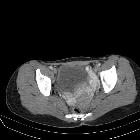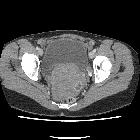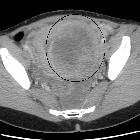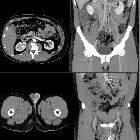Varicocele der Vena ovarica

















Varicocele der Vena ovarica
Varikozele Radiopaedia • CC-by-nc-sa 3.0 • de
Varicocele is the dilatation of the pampiniform plexus of veins, a network of many small veins found in the male spermatic cord. It is the most frequently encountered mass of the spermatic cord.
Epidemiology
The estimated incidence is at ~15% of the general male population and ~40% of subfertile and infertile men (the most common cause of correctable male infertility).
Varicoceles are rare in children under the age of ten years, however they may be seen in up to 10-15% adolescents .
Clinical presentation
Varicoceles can be asymptomatic. If symptomatic, presentations include:
- scrotal mass/swelling
- scrotal pain
- testicular atrophy
- infertility or subfertility
Pathology
The pampiniform veins normally act as heat exchangers, important in the thermoregulation of the testes which is vital for spermatogenesis. A varicocele disturbs this balance and causes heating up of the testis to the normal core body temperature (37ºC), whereas they are normally maintained at a temperature of 35ºC.
Etiology
A varicocele can be classified as primary or secondary.
Primary varicocele
Most varicoceles are primary and result from incompetent or congenitally-absent valves in the testicular vein (internal spermatic vein).
The left testicle is affected much more commonly (≈85%) than the right. This may be due to the shorter course of the right testicular vein and its oblique insertion into the IVC which creates less backpressure. Bilateral varicoceles are not uncommon (≈15%), but isolated right varicoceles are rare and should prompt evaluation for a secondary varicocele.
Secondary varicocele
Secondary varicoceles are much less common and result from increased pressure in the testicular vein due to compression (e.g. extrinsic mass such as retroperitoneal lymphadenopathy), obstruction (e.g. renal vein thrombus), or splenorenal shunting (portal hypertension).
Variants
Radiographic features
Ultrasound
The diagnostic modality of choice:
- dilatation of pampiniform plexus veins >2-3 mm in diameter
- characteristically have a serpiginous appearance
- there can be flow reversal with the Valsalva maneuver
- Doppler ultrasound can be used to grade the degree of reflux
CT
- may show a dilated cluster of enhancing serpiginous veins
Angiography (DSA)
Venography, only performed during endovascular treatment, may demonstrate:
- dilated testicular veins
- retrograde flow of contrast towards the scrotum
- dilated pampiniform plexus should not be directly imaged as the testes should be kept out of the x-ray beam
MRI
- may be incidentally noted during scrotal MRI
- dilated enhancing serpiginous veins
- signal intensity depends on the velocity of flow
- low flow: intermediate T1 and high T2
- high flow: signal void
- enhancement following gadolinium administration
Treatment and prognosis
This is among one of the surgically-correctable causes of male infertility. Management options include:
- embolization of the testicular vein
- surgical ligation of the testicular vein
A unilateral right-sided varicocele is an uncommon finding, and if found, should prompt an evaluation of the retroperitoneum to exclude a mass obstructing the downstream testicular vein.
Siehe auch:
- Varikozele
- Nussknacker-Syndrom
- Arteria mesenterica superior
- Ovarialvenenthrombose
- Phlebolithen in Ovarialvene
- pelvines Kongestionssyndrom
- Vena ovarica
- varikös erweiterte periuterine Venen
- Embolisation Vena ovarica
- ovarian vein embolisation
und weiter:

 Assoziationen und Differentialdiagnosen zu Varicocele der Vena ovarica:
Assoziationen und Differentialdiagnosen zu Varicocele der Vena ovarica:





